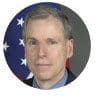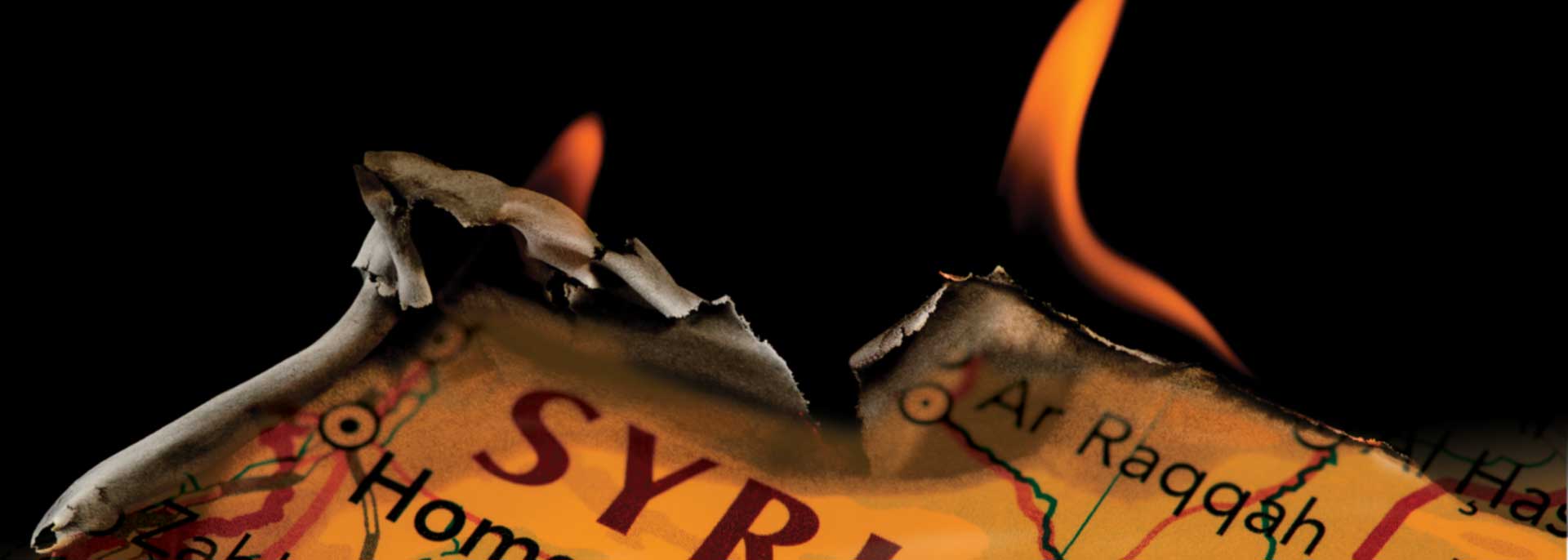Since civil war erupted in Syria in 2011, an estimated 400,000 Syrians have been killed, according to the United Nations. What’s more, some 4.8 million Syrians have fled the country and 6.3 million people are displaced internally. Aleppo, formerly the country’s bustling economic and cultural hub, now lies in rubble—among the nearly 50 percent of the country’s cities that have been completely destroyed by fighting.
How could things have gone so horribly wrong in the region known as “the cradle of civilization?”
To help find answers, we turned to four Johns Hopkins experts who have deep knowledge of the country, its people, its culture, and its politics: Robert Ford ’80, a career member of the U.S. Foreign Service who served as ambassador to Syria from December 2010 until early 2012 when he was recalled for his safety; Sarah Parkinson ’04, Aronson Assistant Professor of Political Science and International Studies, who has conducted extensive fieldwork among Palestinian and Syrian refugees in Lebanon; Glenn Schwartz, chair of the Department of Near Eastern Studies, who conducted archaeological fieldwork in Syria from 1978 to 2010; and Steven David, a professor of international relations in the Department of Political Science, whose work has focused on security threats to American interests including those that stem from the Middle East.
JHU Experts Weigh in on Syria




To Robert Ford ’80, Syria is no distant conflict. In early 2012, after barely a year as U.S. ambassador, he was forced to shutter the U.S. embassy in Damascus, then a prime target for al-Qaeda associates. Evacuation followed standard procedures, but lowering the Stars and Stripes was still a forlorn experience. “When you’re a diplomat,” he says, “closing an embassy is like being a sailor and watching your ship sink.”
Ford had seen the Arab Spring catch light around him in 2011. Night after night in January, Syrians watched satellite TV with rapt attention as popular protest in Tunisia toppled President Zine el-Abidine Ben Ali. When massive demonstrations forced Egyptian President Hosni Mubarak to flee in February, “it was a huge deal in Syria,” the ambassador recalls. “All of a sudden, people we were talking to were saying, ‘Wow, if they did it in Tunisia and Egypt, we can probably do it here.'”
In the wake of Mubarak’s ouster, graffiti in the southern Syrian city of Daraa taunted President Bashar al-Assad, saying, “It’s your turn!” When the dreaded mukhabarat secret police detained and tortured the schoolboys responsible for the graffiti, thousands of indignant Daraans took to the streets. The uprising was not entirely peaceful, concedes Ford—two buildings were torched—but from Daraa on, “the heavy preponderance of violence came from government forces. They were shooting at protesters.”
This bloody scenario was repeated in other Syrian cities. In May 2012, Sarah Parkinson ’04, an assistant professor of political science, was conducting fieldwork in a Palestinian refugee camp near Beirut, Lebanon, “when people from Aleppo started pouring in, saying, ‘Something is going terribly wrong, we just had to get out.'”
In 2008, archaeologist Glenn Schwartz and his team excavated a bronze dagger dating to about 2400 BC, at the site called Umm el-Marra in Syria.
Parkinson encountered terrified former residents of towns seized by the most extreme Islamist rebels. “We’re just getting the hell out,” they told her. By mid-2012, the situation in Syria was so dangerous that Glenn Schwartz, Whiting Professor of Archaeology, could not return to long-running excavations near Aleppo. “Syrian archaeologists would often say, ‘Consider each season as if it were your last,'” he recalls, “but I had gotten complacent.”
The focus of Schwartz’ research since 1994 was Umm el-Marra, a 4,500-year-old settlement he fondly terms “the Baltimore of ancient Syria.” (“It wasn’t one of the big, powerful urban centers,” explains Schwartz. “Probably the capital of a small kingdom.”) Excavating the site’s cemetery in 2000, his Johns Hopkins team uncovered a dazzling assortment of high-status items. These included bronze daggers and spearheads, and exquisite jewelry wrought from gold, silver, and lapis lazuli.
Such finds are the heritage of world civilization. Some of the oldest evidence for a momentous change in human history—the shift to settled farming communities around 12,000 years ago—is found in Syria. And while places like Umm el-Marra were a few centuries behind the curve when it came to the next momentous change—the development of urban communities and written language, some 5,000 years ago—this delay allows archaeologists to determine how the lifestyles of pioneering societies like Mesopotamia and Egypt were adapted to suit the needs of the second wave of settlements, according to Schwartz.
Yet Syria’s archaeological riches have been under threat, and not just from typical war-related damage or opportunistic looting. In what the international agency UNESCO terms “cultural cleansing,” they face deliberate destruction by extreme Islamist groups, for whom even disused ancient shrines are unacceptable idolatry. UNESCO also reports that five out of six World Heritage sites have been damaged, 104 cultural and natural heritage sites have been severely damaged, and 24 have been completely destroyed. Reported in January 2017, a brazen example is ISIS’ wreckage of the imposing amphitheater and tetrapylon at the Roman-era site of Palmyra in Syria’s eastern desert—the group’s second such attack on the oasis city.
“It’s a kind of living nightmare for those of us interested in the cultural heritage of the ancient Near East,” says Schwartz. All he and fellow foreign archaeologists can do is monitor the damage using satellite images, and advise Syrian colleagues on how to safeguard their collections.
(Left) Al-Madina Souq, a covered bazaar in Aleppo, Syria, in 2008, prior to the Syrian civil war. (Right) Al-Madina Souq in January 2017.
Prior to the conflict, some of Schwartz’s favorite antiquities were on display at the National Museum of Aleppo. To get there, he would descend into the bustling city on the road from Damascus—”like going into a big party”—before a 13th-century citadel atop an imposing central mound loomed into view. Nestled below, amid the bubbled roofs of even older mosques and hammam steam baths, was the Al-Madina Souq. This covered bazaar offered Schwartz a sense of living history; with all manner of foodstuffs, jewelry, textiles, and tools being traded along its vaulted passageways just as in its Silk Road heyday.
By 2014, however, the Souq stood abandoned and blackened by fire as the battle for Aleppo raged.
In the spring of that same year, Parkinson’s research took her back to Beirut, observing what had become a full-blown humanitarian catastrophe. Aid officials told her there were now 2 million Syrian refugees in Lebanon—itself a nation of only 4.2 million—and the Palestinian refugee camp where she was based had “literally doubled in height.” Parkinson’s host family had built and moved into a third story; two Syrian families occupied makeshift one-room apartments on the roof. In the evenings, Parkinson would sit up there, teaching the children English by flashlight, due to constant power cuts.
Talk had turned to what to do next. Some Syrian refugees were deliberating how to reach Europe as directly as possible. The hazardous sea route from North Africa was the preferred option. The unsustainably high rents, scarce employment, and bureaucratic barriers to health care and schooling in Lebanon certainly made for a challenging existence.
Then there was fear. One reason Syrians sought refuge in the ramshackle camps was to become invisible: the camps are administered by the Palestine Liberation Organization and inhabited by refugees (and their descendants) who fled violence in Galilee between 1947 and 1948. Syrians who could not afford formal registration fees could live “under the radar” in the camps. But Syria’s presidential elections of June 2014 revealed the enduring reach of the Assad regime.
“You could be undocumented, living in a Palestinian refugee camp,” says Parkinson, “and Syrian government officials”—the omnipresent mukhabarat—”would knock on your door saying, ‘Just remember to go vote.'” There was no choice but a six-hour wait at the polling station, followed by gunshots at nightfall celebrating Bashar al-Assad’s latest victory. “It’s inconceivable that you would vote for someone else,” explains Parkinson. “The reason you have an election isn’t to choose, the reason you have an election is to say he won.”
Intimidation was also the only choice if the Assad regime was to retain power. Back in the early 1900s, when Great Britain and France carved out spheres of influence in the Middle East, they drew borders that paid little heed to where ethnic and religious groups resided. The diverse states that resulted were not inherently unstable, argues Steven David, professor of international relations. But the colonial powers “would empower minority groups”—such as Assad’s Alawites, an offshoot of Shia Islam accounting for only 12 percent of the Syrian population—”as a way of divide and rule.” Today, the Alawites continue to dominate the Syrian military and security services, says David, while the overwhelmingly Sunni Muslim majority “feel disenfranchised and discriminated against, justifiably.”
A recent report by human rights group Amnesty International highlights the scale of brutality required to maintain this status quo. In Saydnaya Prison near Damascus, it estimates, up to 13,000 detainees—mostly political prisoners—were hanged from 2011 through 2015. Ambassador Ford recalls the jail’s “infamous” reputation within Syria, where, he adds grimly, there are further jails “operating on the same scale.”
Fearing their own suppression would follow any Sunni acquisition of power, religious minorities such as Christians and Druze have tended to support Alawite rule in Syria. Yet while the spread of the extreme interpretation of Sunni Islam practiced by ISIS has dominated international news reports, “sectarianism has been read into the conflict much more than it is actually a determining factor,” maintains Parkinson. She recalls significant numbers of Christians—and even mixed Christian-Muslim couples—among refugees in Lebanon. And while others would identify as Muslim, they were flexible about core Islamic precepts such as praying five times a day or abstaining from alcohol. Ambassador Ford also recalls Christians and even Alawites among anti-regime protestors.
This is perhaps not so surprising given Syria’s half a century of secularist Ba’ath Party rule. Truly astonishing, however, was how rapidly demonstrators were able to mount a credible challenge to Assad’s regime in 2011. Here, new forms of communication were crucial. When indignant crowds chanted, “The Syrian people will not be humiliated!” after police beat up a shopkeeper in downtown Damascus that February, bystanders filmed them with their cell phones and uploaded the scenes to YouTube. Thereafter, “the thing spread like wildfire,” Ford recalls. For refugees in Lebanon, messaging applications such as WhatsApp and Viber remain vital tools for navigating the logistics of long-distance travel and even courtship. Forced to flee, says Parkinson, cell phones were “probably the first thing people grabbed when they ran out of the house.”
Ambassador Ford had already seen how advances in communication technology were transforming Arab perceptions of the outside world. As U.S. ambassador to Algeria a few years before the Arab Spring, Ford sensed a sea change when university students who had never been to America expressed a surprising admiration for its police officers. The reason, it turned out, was that they had viewed criminal suspects being read their Miranda rights when arrested in the American TV series “NCIS,” whereas “the Algerian police don’t do that.” Increased awareness of life outside the Arab world, believes Ford, has brought people to “a far greater set of expectations of what their government should do and how it should treat them.” He does not believe the Arab Spring is over.
In the Syrian uprising, however, such idealism was also tempered by naivete. Ford recalls warning the opposition to have nothing to do with the terrorist group al-Qaeda in Iraq, as they would only contaminate efforts to bring freedom and democracy to Syria. “But the opposition people would say to me, ‘They’re not so bad, first we’ll get rid of Assad, and then we’ll be able to talk to them and convince them of their errors.'”
Another wide-eyed belief was that if Assad’s brutality worsened, President Barack Obama would send in the U.S. Air Force. On hearing this, Ford would urge opposition leaders to seek an alternative, political strategy, “because the American Air Force is not going to come. And they would say to me, ‘You’re wrong, Mr. Ambassador!’ And I would say to them, ‘Do you really think you know America better than I do?'”
In Lebanon, Parkinson recalls entering similar arguments among opposition circles, deliberating over coffee about what had gone awry. One popular theory ran that the U.S. wanted Syria to collapse in order to destroy the entire Middle East. “Look, the U.S. doesn’t actually know much about Syria,” she would interject. “Your bigger problem is that the U.S. doesn’t understand why we should care.” Yet the response was incredulity. “That’s impossible, the U.S. knows everything!”
Perhaps also naively, these activists never expected to be shot at by Assad’s troops, says Parkinson. “Snipers on the roof shooting into protests—that shocked them.” They were thus woefully unprepared to fight back. In Syria, she says, few people kept weapons at home—unlike in Lebanon, which saw intense civil conflict during the 1980s.
The Syrian opposition was not alone in being caught unaware, however. If a poll of Middle East experts had been taken in 2011, Steven David judges most would not have guessed that Assad would still be in power six years later. “Obama—and many observers—felt that Assad’s days were numbered,” he recalls. Yet Assad did cling on, partly because fellow Alawites retained control of the military and security forces, and partly, continues David, because “you had Iran come in. Iran enlisted Shiite militias”— Hezbollah—”that really have provided the shock troops to defend the Assad regime.” Together with Russia’s military support, he maintains, “that made the difference.”
Timeline
- March 2011: Violence flares in Daraa, Syria, after teens are arrested for writing political graffiti. Dozens of people are killed when security forces crack down.
- February 2011: The U.S. closes its embassy in Damascus and recalls its diplomats.
- February 2013: The U.N. Security Council estimates that close to 70,000 civilians have been killed in the two-year civil war.
- May 2013: The U.N.’s refugee agency reports that more than 1.5 million Syrians have left their country to escape the war.
- June 2014: President Bashar al-Assad is re-elected, receiving 88.7 percent of the vote in the country’s first election since civil war broke out in 2011.
- September 2014: The U.S. and allies launch airstrikes against ISIS targets in Syria, focusing on the city of Ar Raqqah.
- September 2015: A Pentagon spokesperson says the Russian military appears to be attempting to set up a forward operating base in western Syria; Vladimir Putin says that Russia is supporting the Syrian government in its fight against ISIS’ “terrorist aggression.”
- March 2016: Russia starts withdrawing its forces from Syria. A spokeswoman for Bashar al-Assad tells CNN that the Russian campaign is winding down after achieving its goals of helping Syrian troops take back territory claimed by terrorists.
- December 2016: Syria’s state-run media announces government forces have taken full control of Allepo, ending more than four years of rebel rule there.
- April 2017: The U.S. launches a military strike on a Syrian government airbase in response to the chemical weapon attack that reportedly killed dozens of civilians.
Source: www.cnn.com
What could have been done differently? Even if the U.S. had realized early on that Assad would not budge, says Ford, “I don’t know what alternative policy there would have been. Would we have said, ‘There should never be freedom in Syria?’ While there are demonstrations where literally hundreds of thousands of people are calling for freedom? That would be a very hard thing for an American government to say.”
The overriding factor behind U.S. inaction, says Ford, was that the Obama administration thought from the beginning that “any deep involvement in Syria would necessarily lead to the dispatch of large numbers of American forces into Syria, and a repeat of the Iraq War.” David resents the notion that there was a binary choice between doing nothing and an Iraq-style intervention. Given that more than 400,000 Syrians have been killed, and another 4 million-plus have fled the country, he insists, “it is morally diminishing that we allowed this horror to take place.” Add on the unsettling of European and U.S. politics due to refugee flows, and the potentially destabilizing extension of Iranian and Russian influence in the Middle East, and “there are a lot of costly implications for doing nothing.”
One effective—if tricky—measure, believes David, would have been the institution of a no-fly zone. Ford agrees that this could have “relieved part of the human tragedy with the refugees, and of course the horrific number of civilian casualties from the bombing.” He notes, however, that no-fly zones were enforced over parts of Iraq for more than 10 years. “It never brought Saddam Hussein to the negotiating table, and I don’t think it would have brought Assad to the negotiating table.”
Parkinson says that enforcement of a no-fly zone could still have required tens of thousands of U.S. troops, and Assad would have used Syria’s robust air defenses and helicopters to circumvent it anyway. “This is a government that is intent on maintaining control at any cost.” She says she is saddened that much of the debate of how to “help Syrians” was premised upon explicitly military intervention costing billions of dollars, while humanitarian agencies went grossly underfunded. “If the goal of intervention was to alleviate suffering, then there were people suffering—there are people suffering. Humanitarian stuff is pretty cheap compared to bombs, in all honesty.” This is not to say Parkinson is a pacifist. Her academic research into militant organizations in the region has taught her that help with communications and logistics can go a long way to aid an opposition. “There’s an awful lot you can do with radios,” for example, “as long as you are fed.”
Conversely, U.S. responses ostensibly aimed at boosting security may actually undermine peacekeeping efforts in the Middle East. Blocked at the time of this writing, President Trump’s January 2017 executive order barring people from Syria, Iraq, and five other majority-Muslim countries from entering the U.S. alarms Ambassador Ford.
“No Syrian refugee has been implicated in any terrorist activity,” he insists. “That’s zero out of 15,000. That’s a pretty good number.” The measure is likely to hamper ongoing efforts by U.S. military operations seeking to crush ISIS in Iraq, he maintains. Since only around 2 percent of participating U.S. personnel speak Arabic, estimates Ford, they are heavily dependent upon local translators. “And now ISIS is turning out videos aimed specifically at those translators, saying, ‘See how the Americans treat you? Don’t work with them.'”
It was an Arabic language undergraduate course at Johns Hopkins that drew Parkinson into what she discovered to be a life-enriching culture. She cites “the generosity and the kindness and the humanity and the innovation of people who did not have to welcome me into their lives.” Looking to reciprocate, Parkinson is soon headed for Dulles International Airport to take on a volunteer shift with legal aid organizations assisting arrivals affected by the January executive order. “I’m Sarah,” her greeter’s nametag says simply, “I speak Arabic.” ■
Geraldine Fagan is a British journalist specializing in religious affairs in the former Soviet Union. Based in Moscow from 1999 to 2013, she is the author of Believing in Russia – Religious Policy After Communism.




